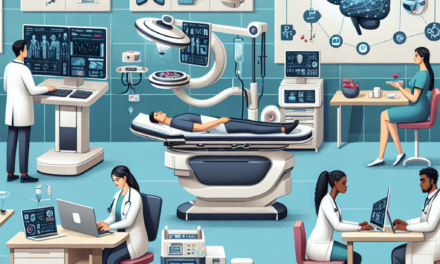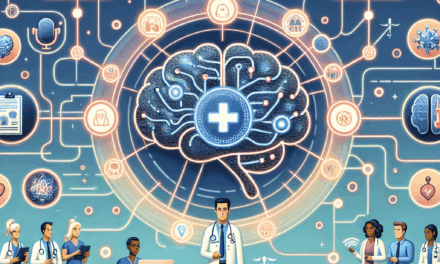ViVE 2025: The Transformative Power of Ambient Intelligence in Healthcare
The healthcare landscape is undergoing a seismic shift, driven by technological advancements and the increasing demand for personalized patient care. As we look towards ViVE 2025, a pivotal event in the healthcare technology sector, one of the most promising innovations on the horizon is ambient intelligence. This concept, which refers to the integration of smart technologies into everyday environments, has the potential to revolutionize healthcare delivery, enhance patient experiences, and improve outcomes. In this article, we will explore the transformative power of ambient intelligence in healthcare through five key subtopics: the definition and components of ambient intelligence, its applications in patient care, the role of data analytics, ethical considerations, and future trends and challenges.
Understanding Ambient Intelligence
Ambient intelligence (AmI) is a multidisciplinary field that combines elements of artificial intelligence, ubiquitous computing, and human-computer interaction. It envisions environments that are sensitive, adaptive, and responsive to the presence of individuals. In healthcare, this means creating spaces that can monitor patients, provide real-time feedback, and facilitate seamless interactions between patients and healthcare providers.
Key components of ambient intelligence include:
- Ubiquitous Computing: The integration of computing devices into everyday objects and environments, allowing for constant connectivity and data exchange.
- Context Awareness: The ability of systems to understand and respond to the context in which they operate, including the physical environment and the behaviors of individuals.
- Artificial Intelligence: The use of machine learning algorithms and data analytics to interpret data, make predictions, and automate processes.
- Human-Centric Design: Designing technology that prioritizes user experience, ensuring that systems are intuitive and accessible to all users.
In healthcare, ambient intelligence can manifest in various forms, such as smart home devices that monitor vital signs, wearable health trackers that provide real-time feedback, and intelligent hospital environments that adapt to patient needs. The goal is to create a seamless integration of technology into the healthcare experience, enhancing both patient care and operational efficiency.
Applications of Ambient Intelligence in Patient Care
The applications of ambient intelligence in patient care are vast and varied, offering innovative solutions to some of the most pressing challenges in healthcare today. From remote monitoring to personalized treatment plans, ambient intelligence is poised to enhance the quality of care and improve patient outcomes.
One of the most significant applications is in the realm of remote patient monitoring. With the rise of chronic diseases and an aging population, healthcare providers are increasingly turning to technology to monitor patients outside of traditional clinical settings. Ambient intelligence enables the use of smart devices that can track vital signs, medication adherence, and lifestyle choices in real-time. For example:
- Wearable Devices: Smartwatches and fitness trackers can monitor heart rate, activity levels, and sleep patterns, providing valuable data to healthcare providers.
- Smart Home Sensors: Devices that can detect falls or changes in daily routines can alert caregivers or family members, ensuring timely intervention.
Another critical application is in personalized treatment plans. By leveraging data analytics and machine learning, healthcare providers can analyze patient data to develop tailored treatment strategies. For instance, ambient intelligence can help identify patterns in a patient’s health data, allowing for proactive adjustments to treatment plans based on real-time feedback.
Moreover, ambient intelligence can enhance patient engagement and education. Interactive health applications can provide patients with personalized information about their conditions, treatment options, and lifestyle changes. This empowers patients to take an active role in their healthcare journey, leading to better adherence to treatment plans and improved health outcomes.
The Role of Data Analytics in Ambient Intelligence
Data analytics is a cornerstone of ambient intelligence in healthcare. The ability to collect, analyze, and interpret vast amounts of data is essential for creating intelligent systems that can respond to patient needs effectively. In the context of ambient intelligence, data analytics serves several critical functions:
- Real-Time Monitoring: Continuous data collection from various sources allows for real-time monitoring of patient health, enabling timely interventions when necessary.
- Predictive Analytics: By analyzing historical data, healthcare providers can identify trends and predict potential health issues before they arise.
- Personalization: Data analytics enables the customization of treatment plans based on individual patient data, leading to more effective care.
For example, a study published in the journal “Health Affairs” found that predictive analytics could reduce hospital readmissions by up to 20% by identifying high-risk patients and implementing targeted interventions. This not only improves patient outcomes but also reduces healthcare costs.
Furthermore, data analytics can enhance operational efficiency within healthcare organizations. By analyzing workflow data, hospitals can identify bottlenecks and optimize resource allocation, leading to improved patient flow and reduced wait times. This is particularly important in emergency departments, where timely care can be a matter of life and death.
Ethical Considerations in Ambient Intelligence
As with any technological advancement, the integration of ambient intelligence in healthcare raises important ethical considerations. The use of smart technologies and data analytics must be balanced with the need to protect patient privacy and ensure informed consent.
One of the primary concerns is data privacy. The collection of sensitive health information through ambient intelligence devices necessitates robust security measures to prevent unauthorized access and data breaches. Healthcare organizations must implement stringent data protection protocols and ensure compliance with regulations such as the Health Insurance Portability and Accountability Act (HIPAA) in the United States.
Informed consent is another critical ethical consideration. Patients must be fully informed about how their data will be used and have the right to opt-out of data collection if they choose. This requires transparent communication from healthcare providers and technology developers about the benefits and risks associated with ambient intelligence.
Moreover, there is a risk of exacerbating health disparities if access to ambient intelligence technologies is not equitable. Ensuring that all patients, regardless of socioeconomic status, have access to these innovations is essential for promoting health equity. This may involve addressing barriers such as cost, digital literacy, and access to reliable internet services.
Future Trends and Challenges in Ambient Intelligence
As we look towards the future, several trends and challenges will shape the landscape of ambient intelligence in healthcare. Understanding these factors is crucial for stakeholders aiming to harness the full potential of this transformative technology.
One significant trend is the increasing integration of artificial intelligence and machine learning into ambient intelligence systems. As these technologies continue to evolve, we can expect more sophisticated algorithms that can analyze complex health data and provide actionable insights. This will enhance the ability of healthcare providers to deliver personalized care and improve patient outcomes.
Another trend is the growing emphasis on interoperability. For ambient intelligence to be effective, different systems and devices must be able to communicate and share data seamlessly. This requires collaboration between technology developers, healthcare providers, and regulatory bodies to establish standards and protocols for data exchange.
However, challenges remain. The rapid pace of technological advancement can outstrip regulatory frameworks, leading to uncertainty about compliance and liability. Additionally, the high cost of implementing ambient intelligence solutions may pose barriers for smaller healthcare organizations.
Finally, as ambient intelligence becomes more prevalent, ongoing education and training for healthcare professionals will be essential. Ensuring that providers are equipped to leverage these technologies effectively will be critical for maximizing their impact on patient care.
Conclusion
As we approach ViVE 2025, the transformative power of ambient intelligence in healthcare is becoming increasingly evident. From enhancing patient care through remote monitoring and personalized treatment plans to leveraging data analytics for improved outcomes, the potential benefits are vast. However, ethical considerations and challenges must be addressed to ensure that these innovations are implemented responsibly and equitably.
The future of healthcare is undoubtedly intertwined with ambient intelligence, and stakeholders must work collaboratively to navigate the complexities of this evolving landscape. By embracing the opportunities presented by ambient intelligence while remaining vigilant about ethical implications, we can create a healthcare system that is not only more efficient but also more responsive to the needs of patients.
In summary, ambient intelligence represents a paradigm shift in healthcare, one that promises to enhance the quality of care, improve patient experiences, and ultimately transform the way we approach health and wellness. As we look ahead to ViVE 2025 and beyond, the journey towards a more intelligent and connected healthcare ecosystem is just beginning.





